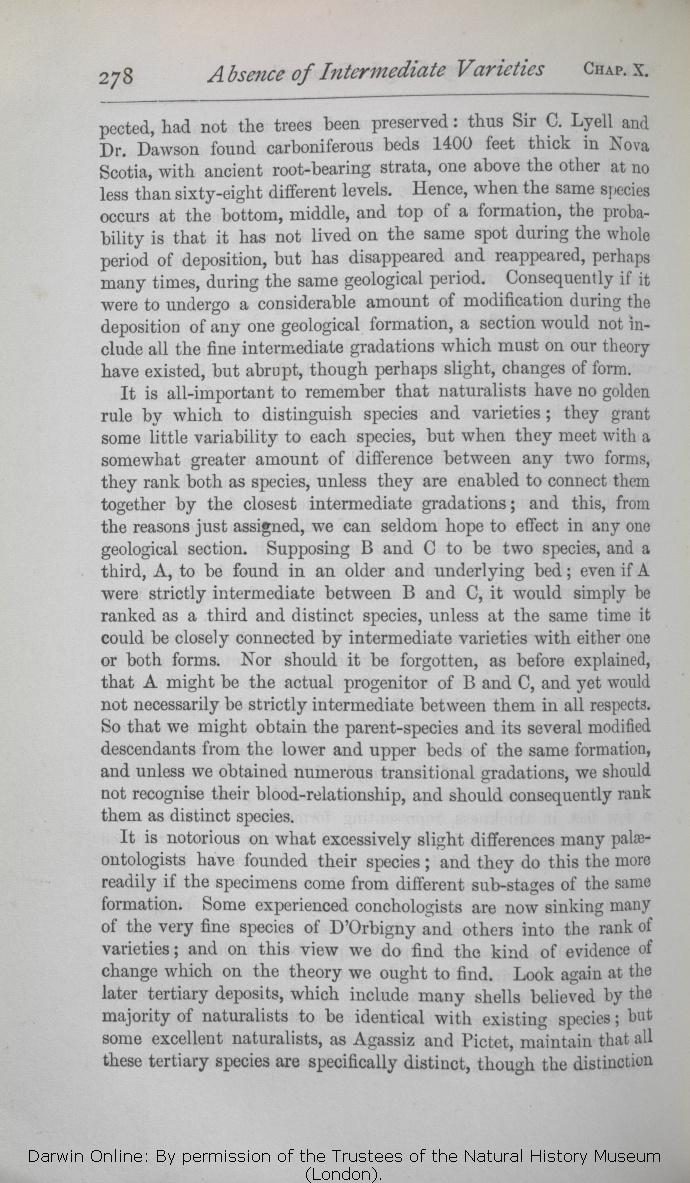sus- pected, | sus- pected, 1872 | | suspected, 1859 1860 1861 1866 1869 |
| OMIT 1872 |
| chanced to have 1859 1860 1861 1866 1869 |
| thus 1860 1861 1866 1869 1872 | | thus, 1859 |
| Sir C. 1866 1869 1872 | | Messrs. 1859 1860 1861 |
| Dr. Dawson 1866 1869 1872 | | Dawson 1859 1860 1861 |
| other 1872 | | other, 1859 1860 1861 1866 1869 |
| occurs 1872 | | occur 1859 1860 1861 1866 1869 |
| it has 1872 | | they have 1859 1860 1861 1866 1869 |
| has 1872 | | have 1859 1860 1861 1866 1869 |
| Consequently if it 1872 |
| So that if such species 1859 1860 1861 |
| So that, if such species 1866 1869 |
| the deposition of any 1872 |
| any 1859 1860 1861 1866 1869 |
| formation, 1872 | | period, 1859 1860 1861 1866 1869 |
| ..... 1869 1872 | | probably 1859 1860 1861 1866 |
| our 1869 1872 | | my 1859 1860 1861 1866 |
| existed, 1872 | | existed 1859 1860 1861 1866 1869 |
| ..... 1872 | | between them, 1859 1860 1861 1866 1869 |
| ..... 1861 1866 1869 1872 | | very 1859 1860 |
|
|
It is all-important to remember that naturalists have no golden rule by which to distinguish species and varieties; they grant some little variability to each species, but when they meet with a somewhat greater amount of difference between any two forms, they rank both as species, unless they are enabled to connect them together by
the closest | the closest 1866 1869 1872 | | close 1859 1860 1861 |
| gradations; 1872 | | gradations. 1859 1860 1861 1866 1869 |
| and 1872 | | And 1859 1860 1861 1866 1869 |
| this, 1872 | | this 1859 1860 1861 1866 1869 |
| assigned, 1872 | | assigned 1859 1860 1861 1866 1869 |
| older and underlying 1869 1872 |
| underlying 1859 1860 1861 1866 |
| bed; 1859 1860 1869 1872 |
| and older bed; 1861 1866 |
| ..... 1872 | | most 1859 1860 1861 1866 1869 |
| by intermediate varieties with 1872 |
| with 1859 1860 1861 1866 1869 |
| forms. 1872 | | forms 1859 1860 1861 1866 1869 |
| ..... 1872 | | by 1859 1860 1861 1866 1869 |
| ..... 1872 | | intermediate 1859 1860 1861 1866 1869 |
| ..... 1872 | | varieties. 1859 1860 1861 1866 1869 |
| would 1872 | | might 1859 1860 1861 1866 1869 |
| ..... 1866 1869 1872 | | at all 1859 1860 1861 |
| respects. 1866 1869 1872 |
| points of structure. 1859 1860 1861 |
| the same 1869 1872 | | a 1859 1860 1861 1866 |
| blood-relationship, 1861 1866 1869 1872 | | relationship, 1859 1860 |
| OMIT 1872 |
| be compelled to 1859 1860 1861 1866 1869 |
| ..... 1869 1872 | | all 1859 1860 1861 1866 |
|
|
It is notorious on what excessively slight differences many palæontologists have founded their species; and they do this the more readily if the specimens come from different sub-stages of the same formation. Some experienced conchologists are now sinking many of the very fine species of
D'Orbigny | D'Orbigny 1859 1860 1861 1866 1872 | | D''Orbigny 1869 |
| the 1869 1872 | | my 1859 1860 1861 1866 |
|









